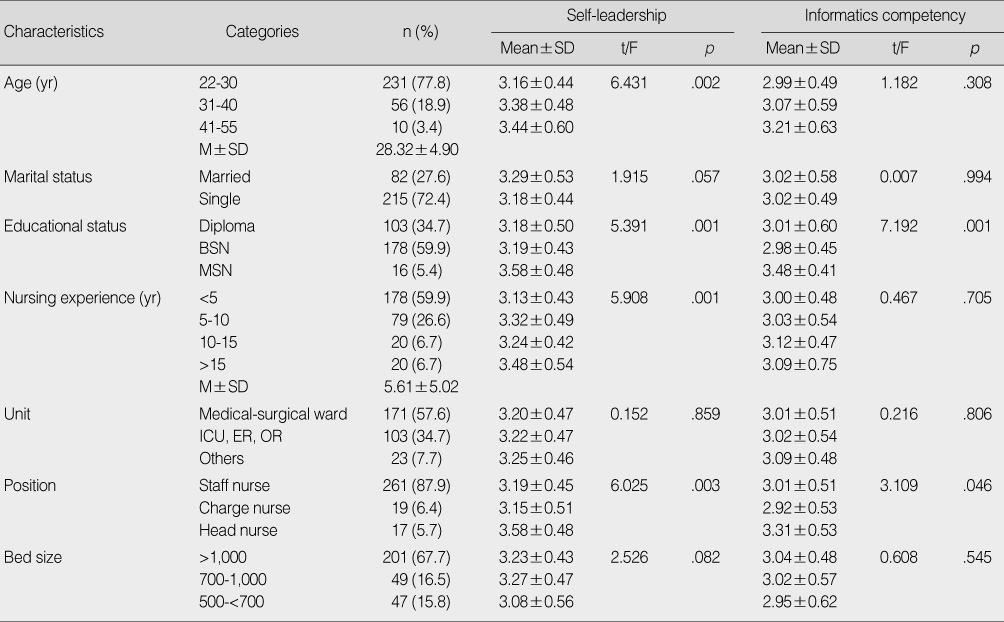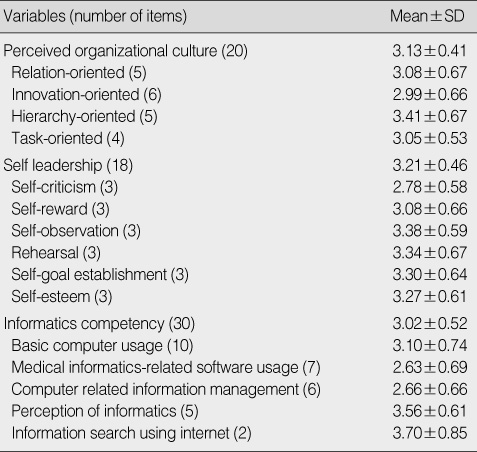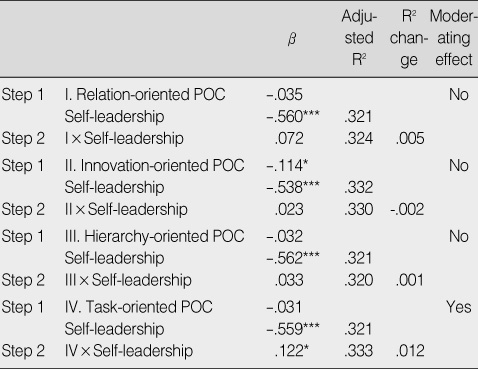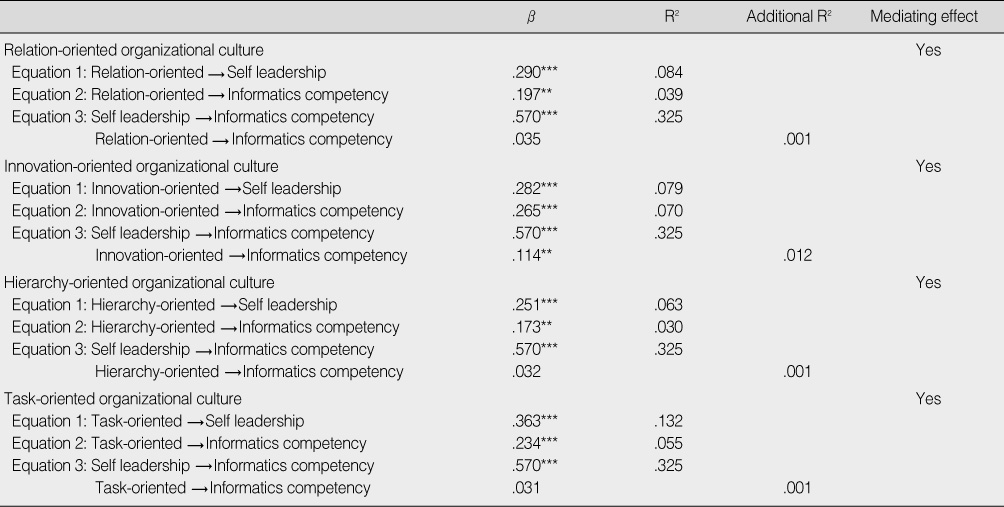Articles
- Page Path
- HOME > J Korean Acad Nurs > Volume 39(5); 2009 > Article
-
Original Article
- Role of Self-Leadership in the Relationship between Organizational Culture and Informatics Competency
- Myoung Soo Kim
-
Journal of Korean Academy of Nursing 2009;39(5):731-740.
DOI: https://doi.org/10.4040/jkan.2009.39.5.731
Published online: October 31, 2009
Assistant Professor, Department of Nursing, Ulsan College, Ulsan, Korea.
- Address reprint requests to: Kim, Myoung Soo. Department of Nursing, Ulsan College, 101 Bongsu-ro, Dong-gu, Ulsan 682-715, Korea. Tel: 82-52-230-0737, Fax: 82-52-230-0730, kanosa@hanmail.net
Copyright © 2009 Korean Society of Nursing Science
Abstract
-
Purpose
- The purpose of this study was to identify the moderating and mediating effects of self-leadership in the relationship between organizational culture and nurses' informatics competency.
-
Methods
- Participants in this study were 297 nurses from the cities of Busan and Ulsan. The scales of organizational culture, self-leadership and informatics competency for nurses were used in this study. Descriptive statistics, Pearson correlation coefficient, stepwise multiple regression were used for data analysis.
-
Results
- Nursing informatics competency of the participants was relatively low with a mean score 3.02. There were significant positive correlations between subcategories of perceived organizational culture, self-leadership and nursing informatics competency. Self-leadership was a moderator and a mediator between organizational culture and informatics competency.
-
Conclusion
- Based on the results of this study, self-leadership promotion strategies to improve nursing informatics competency are needed.
- 1. Aarons GA, Sawitzky AC. Organizational climate partially mediates the effect of culture on work attitudes and staff turnover in mental health services. Administration and Policy in Mental Health. 2006;33:289–301.ArticlePubMedPMCPDF
- 2. Aroian J, Breton O. Nursing informatics in a registered nurse graduate program. Study in Health Technology Informatics. 1997;46:191–194.PubMed
- 3. Ash J. Organizational factors that influence information technology diffusion in academic health sciences centers. Journal of American Medical Informatics Association. 1997;4:102–111.Article
- 4. Cherry B, Carter M, Owen D, Lockhart C. Factors affecting electronic health record adoption in long-term care facilities. Journal of Healthcare Quality. 2008;30(2):37–47.Article
- 5. Courtney KL, Demiris G, Alexander GL. Information technology: Changing nursing processes at the point-of-care. Nursing Administration Quarterly. 2005;29:315–322.ArticlePubMed
- 6. Darr A, Harrison MI, Shakked L, Shalom N. Physicians' and nurses' reactions to electronic medical records. Managerial and occupational implications. Journal of Health Organization Management. 2003;17:349–359.PubMed
- 7. Dolbier CI, Soderstrom M, Steinhardt MA. The relation between self-leadership and enhanced psychological, health, and work outcomes. Journal of Psychology. 2001;125:469–486.
- 8. Han SJ. A study on the relationship between nursing organizational culture and organizational performance. Journal of Korean Academy of Nursing Administration. 2002;8:441–456.
- 9. Ivanitskaya L, O'Boyle I, Casey AM. Health information literacy and competencies of information age students: Results from the interactive online Research Readiness Self-Assessment (RRSA). Journal of Medical Internet Research. 2006;8(2):e6. ArticlePubMedPMC
- 10. Jeong SH. The effect of information technology application on knowledge management process in clinical nurses. Journal of Korean Academy of Nursing Administration. 2004;10:141–159.
- 11. Jeong YJ. The development and application of the self-leadership program for young children. 2008;Iksan, Wonkwang University. Unpublished master's thesis.
- 12. Khomeiran RT, Yekta ZP, Kiger AM, Ahmadi F. Professional competence: Factors described by nurses as influencing their development. International Nursing Review. 2006;53:66–72.ArticlePubMed
- 13. Kim HS. The relationship between teachers' self-leadership and the job satisfaction at secondary schools. 2002;Seoul, Soongsil University. Unpublished master's thesis.
- 14. Kim KO, Kim BH, Kim YS, Jeon HW. A study on the relationships among nursing organizational characteristics, types of nursing organizational culture and team effectiveness at operating rooms. Journal of Korean Academy of Nursing Administration. 2006;12:385–396.
- 15. Kim MJ. An inquiry into learner factors influencing the self-leadership development of university students. 2006;Seoul, Ewha Womans University. Unpublished master's thesis.
- 16. Kim MS. Validity and reliability of informatics competencies for nurses among Korean nurses. Journal of Korean Academy of Adult Nursing. 2008;20:470–480.
- 17. Kim MS, Han SJ, Kim JH. The development of the nursing organization culture measurement tool. Journal of Korean Academy of Nursing Administration. 2004;10:175–184.
- 18. Lee EJ. The Nursing Minimum Data Set (NMDS) and its relationship with the Nursing Management Minimum Data Set (NMMDS): Significance, development, and future of nursing profession. Journal of Korean Academy of Nursing. 2001;31:401–416.ArticlePDF
- 19. Lee M, Delaney C, Moorhead S. Building a personal health record from a nursing perspective. International Journal of Medical Informatics. 2007;76:308–316.
- 20. Lin JS, Yen-Chi L, Lee TT. A study of network education application on nursing staff continuing education effectiveness and staff's satisfaction. Studies in Health Technology and Informatics. 2006;122:801–803.PubMed
- 21. Manz C, Neck CP. Mastering self-leadership. 1999;Upper Saddle River, NJ, Prentice Hall.
- 22. McNeil BJ, Elfrink VL, Bickford CJ, Pierce ST, Beyea SC, Averill C, et al. Nursing information technology knowledge, skills, and preparation of student nurses, nursing faculty, and clinicians: A US Survey. Journal of Nursing Education. 2003;42:341–349.ArticlePubMed
- 23. Quinn RE, McGrath MR. The transformation of organizational culture: A competing values perspective. 1985;Berverly Hills, CA, Sage Publications.
- 24. Seo JW. In : Jang BC. Induction of safety and convenient electric chart. In: U-Health, the blue ocean of medicine & healthcare. 2008;05;In: Symposium conducted at the meeting of the spring conference of Korean Society of Medical Informatics; Seoul.
- 25. Seomun GA, Chang SO, Cho KH, Kim IA, Lee SJ. The relation between self-leadership and outcome of nursing practice. Journal of Korean Academy of Nursing Administration. 2006;12:151–158.
- 26. Snijders T, Bosker R. Multi-level analysis. An introduction to basic and advanced multi-level modeling. 1999;London, Sage Publications.
- 27. Staggers N, Gassert CA, Curran C. Informatics competencies for nurses at four levels of practice. Journal of Nursing Education. 2001;40:303–315.ArticlePubMed
- 28. Tabachnick BG, Fidell LS. Using multivariate statistics. 2001;4th ed.Boston, MA, Allyn & Bacon.
- 29. Willmer M. How nursing leadership and management interventions could facilitate the effective use of information and communications technology (ICT) by student nurses. Journal of Nursing Management. 2007;15:207–213.PubMed
- 30. Ying L, Kunaviktikul W, Tonmukayakal O. Nursing competency and organizational climate as perceived by staff nurses in a Chinese university hospital. . Nursing & Health Sciences. 2007;9:221–227.Article
- 31. Yom YH. The development and effect analysis of an internet based nursing program: Application to nursing informatics. Journal of Korean Academy Nursing. 2000;30:1035–1044.ArticlePDF
REFERENCES



Figure & Data
REFERENCES
Citations

- Competency in Nursing Informatics of Health Educators
YoungRan Chin, Hyun Kim
The Open Public Health Journal.2022;[Epub] CrossRef - A study on nursing informatics competence of clinical nurses: Applying focus group interview
Seon Mi Jang, Jeongeun Kim
The Journal of Korean Academic Society of Nursing Education.2020; 26(3): 299. CrossRef - Relationships among demands at work, aggression, and verbal abuse among registered nurses in South Korea
Hyoung Eun Chang, Mi Youn Park, Haena Jang, Shinae Ahn, Hyo-Jeong Yoon
Nursing Outlook.2019; 67(5): 567. CrossRef - A Predictive Model on Patient-Centered Care of Hospital Nurses in Korea
Hyun Jeong, Myonghwa Park
Journal of Korean Academy of Nursing.2019; 49(2): 191. CrossRef - Mediating Effects of Self-leadership in the Relationship between Public Health Nurses' Organizational Culture and Their Job Performance
Nam Hee Park, Kyung Jo Lee, Sang Ju Lee
Journal of Korean Academy of Community Health Nursing.2017; 28(1): 23. CrossRef - Relationship among Types of Nursing Organizational Culture, Self-leadership and Burnout as Perceived by Perioperative Nurses
Minkyung Im, Young-Hee Sung, Junghee Jung
Journal of Korean Academy of Nursing Administration.2017; 23(2): 170. CrossRef - Factors Influencing Intention to Use Smart-based Continuing Nurse Education*
Myoung Soo Kim, Sungmin Kim, Hyun Kyeong Jung, Myoung Hee Kim
Journal of Korean Academy of Fundamentals of Nursing.2016; 23(1): 51. CrossRef - The Influence of Nursing Informatics Competency on Job-Satisfaction and Nursing Performance
Jeon-Ma Lee, In-Sun Gang, Su-Jeong Yu
The Korean Journal of Health Service Management.2015; 9(1): 109. CrossRef - Development and Validity of Workplace Bullying in Nursing-Type Inventory (WPBN-TI)
Younju Lee, Mihyoung Lee
Journal of Korean Academy of Nursing.2014; 44(2): 209. CrossRef - Job Competencies and Educational Needs Perceived by New Community Health Practitioners
Hyun Kyung Kim, Young Eun, Kyung Ja June, Ae Young So, Hee Gerl Kim, Mi Ran Eom, Yeon Yi Song, Eun Suk Choi, Ji Yeon Park, Hyoung Suk Kim
Journal of Korean Academy of Community Health Nursing.2014; 25(2): 85. CrossRef - Nursing Informatics Competencies of Public Health Nurses in Chungcheongnam-do
Hyun Kim, Miyoung Kim
Journal of Korean Academy of Community Health Nursing.2013; 24(1): 20. CrossRef - A Review of Research on Self-leadership in Nurses'
Hyo Jin Won, Sung Hyun Cho
Journal of Korean Academy of Nursing Administration.2013; 19(3): 382. CrossRef - Impact of Critical Thinking Disposition, General Self-Efficacy, and Leadership on Clinical Competence in Nursing Students
Jee Won Park, Chun-Ja Kim, Yong Soon Kim, Moon Sook Yoo, Hyera Yoo, Sun-Mi Chae, Jeong-Ah Ahn
Korean Journal of Medical Education.2012; 24(3): 223. CrossRef - Nursing Core Competencies Needed in the Fields of Nursing Practice for Graduates in Nursing
Sun-kyoung Lee, Sun Nam Park, Seok Hee Jeong
Journal of Korean Academy of Nursing Administration.2012; 18(4): 460. CrossRef - The Changes of Self-esteem and Leadership during Two Years in Nursing Students
Sei-Young Oh, Sun-Nam Park
The Journal of Korean Academic Society of Nursing Education.2010; 16(2): 186. CrossRef - Canonical Correlation between Organizational Culture and Informatics Competency
Myoung Soo Kim
Journal of Korean Academy of Nursing Administration.2010; 16(2): 172. CrossRef
Self-Leadership and Informatics Competency according to Participants' Characteristics (N=297)
BSN=bachelor of science in nursing; MSN=master of science in nursing; ICU=intensive care unit; ER=emergency room; OR=operating room.
Perceived Organizational Culture, Self-Leadership, Informatics Competency of Participants (N=297)
Pearson Correlation Coefficients for Perceived Organizational Culture, Self-Leadership and Informatics Competency (N=297)
POC=perceived organizational culture.
Moderating Effect of Self-Leadership on the Relationship between Perceived Organizational Culture and Informatics Competency (N=297)
POC=perceived organizational culture.
*p<.05; ***p<.001.
Mediating Effects of Self-Leadership in the Relationship between Organizational Culture and Informatics Competency (N=297)
**p<.01; ***p<.001.
BSN=bachelor of science in nursing; MSN=master of science in nursing; ICU=intensive care unit; ER=emergency room; OR=operating room.
POC=perceived organizational culture.
POC=perceived organizational culture. *
**
 KSNS
KSNS
 E-SUBMISSION
E-SUBMISSION


 Cite
Cite

